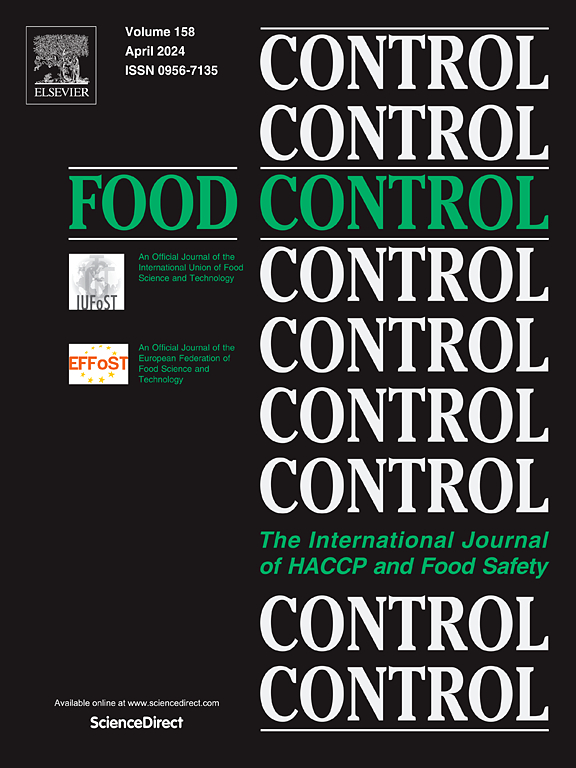Exploring the efficacy of bacteriophage cocktails for mitigating Vibrio contamination within the seafood production chain: A feasible approach to microbial risk management
IF 5.6
1区 农林科学
Q1 FOOD SCIENCE & TECHNOLOGY
引用次数: 0
Abstract
Vibrio species are major foodborne pathogens that pose a significant public health risk, particularly in the seafood production chain. Despite the growing concern over Vibrio contamination, effective strategies for its control are still limited. This gap underscores the urgent need for novel approaches to reduce Vibrio contamination in seafood production environments. In this study, we isolated three novel bacteriophages from natural environments, specifically targeting Vibrio species. Whole-genome sequencing and comparative genomic analysis revealed that these phages belong to the Mardecavirus, Maculvirus, and Vapseptimavirus genera. When formulated as a cocktail, these phages effectively lysed 64.93 % of a diverse panel of 77 Vibrio strains, including Vibrio parahaemolyticus, Vibrio alginolyticus, Vibrio vulnificus, and Vibrio anguillarum. The phage cocktail demonstrated significant efficacy in reducing Vibrio contamination on both food surfaces (three types of seafood) and food contact surfaces (cutting boards and gloves) within the seafood production chain. Safety assessments of the phage cocktail were conducted in vitro using cell models and in vivo using Galleria mellonella larvae and mice models, confirming the formulation's safety profile. These findings highlight the potential of the phage cocktail as a viable biological control agent for mitigating Vibrio contamination in seafood production. Furthermore, the study supports the commercial potential of phage-based biocontrol strategies in the food industry, offering a promising alternative to traditional chemical preservatives.
探索噬菌体鸡尾酒对减轻海鲜生产链中弧菌污染的功效:微生物风险管理的可行方法
弧菌是主要的食源性病原体,对公共卫生构成重大风险,特别是在海产品生产链中。尽管对弧菌污染的关注日益增加,但有效的控制策略仍然有限。这一差距凸显了迫切需要新的方法来减少海产品生产环境中的弧菌污染。在这项研究中,我们从自然环境中分离出三种新的噬菌体,专门针对弧菌物种。全基因组测序和比较基因组分析显示,这些噬菌体属于马尔地卡病毒、Maculvirus和Vapseptimavirus属。当配制成鸡尾酒时,这些噬菌体有效地裂解了77种弧菌菌株的64.93%,包括副溶血性弧菌、溶藻弧菌、创伤弧菌和鳗弧菌。噬菌体鸡尾酒在减少海鲜生产链中食物表面(三种海产品)和食物接触表面(砧板和手套)上的弧菌污染方面显示出显著效果。对噬菌体鸡尾酒进行了体外细胞模型和体内mellonella幼虫和小鼠模型的安全性评估,证实了该配方的安全性。这些发现突出了噬菌体鸡尾酒作为减轻海鲜生产中弧菌污染的可行生物防治剂的潜力。此外,该研究支持了基于噬菌体的生物防治策略在食品工业中的商业潜力,为传统化学防腐剂提供了一个有希望的替代品。
本文章由计算机程序翻译,如有差异,请以英文原文为准。
求助全文
约1分钟内获得全文
求助全文
来源期刊

Food Control
工程技术-食品科技
CiteScore
12.20
自引率
6.70%
发文量
758
审稿时长
33 days
期刊介绍:
Food Control is an international journal that provides essential information for those involved in food safety and process control.
Food Control covers the below areas that relate to food process control or to food safety of human foods:
• Microbial food safety and antimicrobial systems
• Mycotoxins
• Hazard analysis, HACCP and food safety objectives
• Risk assessment, including microbial and chemical hazards
• Quality assurance
• Good manufacturing practices
• Food process systems design and control
• Food Packaging technology and materials in contact with foods
• Rapid methods of analysis and detection, including sensor technology
• Codes of practice, legislation and international harmonization
• Consumer issues
• Education, training and research needs.
The scope of Food Control is comprehensive and includes original research papers, authoritative reviews, short communications, comment articles that report on new developments in food control, and position papers.
 求助内容:
求助内容: 应助结果提醒方式:
应助结果提醒方式:


